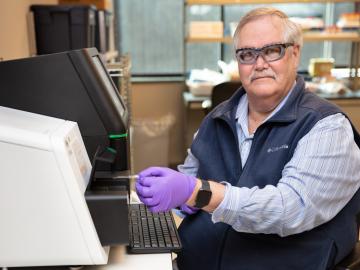
Filter News
Area of Research
- Advanced Manufacturing (7)
- Biological Systems (1)
- Biology and Environment (4)
- Building Technologies (1)
- Clean Energy (61)
- Climate and Environmental Systems (2)
- Computational Engineering (1)
- Computer Science (8)
- Fusion and Fission (1)
- Fusion Energy (6)
- Isotopes (1)
- Materials (57)
- National Security (7)
- Neutron Science (24)
- Nuclear Science and Technology (11)
- Quantum information Science (3)
- Supercomputing (31)
- Transportation Systems (1)
Date
News Topics
- 3-D Printing/Advanced Manufacturing (25)
- Advanced Reactors (10)
- Artificial Intelligence (34)
- Big Data (15)
- Bioenergy (19)
- Biology (11)
- Biomedical (10)
- Biotechnology (6)
- Buildings (13)
- Chemical Sciences (12)
- Clean Water (8)
- Climate Change (19)
- Composites (6)
- Computer Science (53)
- Critical Materials (3)
- Cybersecurity (5)
- Decarbonization (20)
- Education (1)
- Emergency (1)
- Energy Storage (16)
- Environment (37)
- Exascale Computing (7)
- Fossil Energy (2)
- Frontier (8)
- Fusion (9)
- Grid (11)
- High-Performance Computing (13)
- Isotopes (12)
- ITER (1)
- Machine Learning (13)
- Materials (13)
- Materials Science (33)
- Mathematics (2)
- Mercury (1)
- Microscopy (7)
- Molten Salt (1)
- Nanotechnology (8)
- National Security (13)
- Net Zero (5)
- Neutron Science (28)
- Nuclear Energy (24)
- Partnerships (11)
- Physics (10)
- Polymers (7)
- Quantum Computing (10)
- Quantum Science (22)
- Security (4)
- Simulation (12)
- Space Exploration (7)
- Statistics (2)
- Summit (13)
- Sustainable Energy (24)
- Transportation (24)
Media Contacts

OAK RIDGE, Tenn., March 11, 2019—An international collaboration including scientists at the Department of Energy’s Oak Ridge National Laboratory solved a 50-year-old puzzle that explains why beta decays of atomic nuclei

As the rise of antibiotic-resistant bacteria known as superbugs threatens public health, Oak Ridge National Laboratory’s Shuo Qian and Veerendra Sharma from the Bhaba Atomic Research Centre in India are using neutron scattering to study how an antibacterial peptide interacts with and fights harmful bacteria.
Higher carbon dioxide levels caused 30 percent more wood growth in young forest stands across the temperate United States over a decade, according to an analysis led by Oak Ridge National Laboratory.

Oak Ridge National Laboratory is using ultrasonic additive manufacturing to embed highly accurate fiber optic sensors in heat- and radiation-resistant materials, allowing for real-time monitoring that could lead to greater insights and safer reactors.

Geospatial scientists at Oak Ridge National Laboratory analyzed three cities of varying infrastructures to look for patterns of electricity use and locate “dark spots” where informal neighborhoods may lack access to power.

Oak Ridge National Laboratory’s latest Transportation Energy Data Book: Edition 37 reports that the number of vehicles nationwide is growing faster than the population, with sales more than 17 million since 2015, and the average household vehicle travels more than 11,000 miles per year.


OAK RIDGE, Tenn., March 4, 2019—A team of researchers from the Department of Energy’s Oak Ridge National Laboratory Health Data Sciences Institute have harnessed the power of artificial intelligence to better match cancer patients with clinical trials.

OAK RIDGE, Tenn., March 1, 2019—ReactWell, LLC, has licensed a novel waste-to-fuel technology from the Department of Energy’s Oak Ridge National Laboratory to improve energy conversion methods for cleaner, more efficient oil and gas, chemical and



